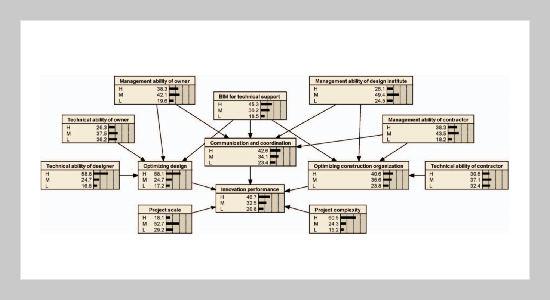REFERENCES
- [1] Deng, X. P., Li, Q. M. and Zhou, Z. P., “Statistical Analysis of Subway Construction Safety Accident Regularity,” Statistics & Decision, Vol. 26, No. 9, pp. 87�89(2010).
- [2] Azhar, S., “Building Information Modeling (BIM): Trends, Benefits, Risks, and Challenges for the AEC Industry,” Leadership and Management in Engineering, Vol. 11, No. 3, pp. 241�252 (2011). doi: 10.1061/ (ASCE)LM.1943-5630.0000127
- [3] Eastman, C., Teicholz, P., Sacks, R. and Liston ,K., BIM Handbook -A Guide to Building Information Modeling for Owners, Managers, Designers, Engineers and Contractors, 2nd ed, Wiley (2011). doi: 10.5130/ ajceb.v12i3.2749
- [4] Linderoth, C., “Understanding Adoption and Use of BIM as the Creation of Actor Networks,” Automation in Construction, Vol. 19, No. 1, pp. 66�72 (2010). doi: 10.1016/j.autcon.2009.09.003
- [5] Risto, T., “Challenges of Implementing New Technologies in the World of BIM: Case Study from Construction Engineering Industry in Finland,” Procedia Economics and Finance, Vol. 21, pp. 469�477 (2015). doi: 10.1016/S2212-5671(15)00201-4
- [6] Hannes, L. and Susanna, V., “BIM Implementation and Organisational Change: A Case Study of a Large Swedish Public Client,” Procedia Economics and Finance, Vol. 21, pp. 178�184 (2015). doi: 10.1016/S2212-5671 (15)00165-3
- [7] Man, Q. P. and Li, X. D. “Collaborative Construction Based on Ubiquitous Computing and BIM,” China Civil Engineering Journal, Vol. 45, No. 2, pp. 311� 315 (2012).
- [8] Liu, R. R. and Li, Z. M., “Modelling Study of P-xylene Oxidative Side-reaction Based on Bayesian Filtering,” Computer Modelling & New Technologies, Vol. 18, No. 2, pp. 95�98 (2014).
- [9] Tu, J. X., “Retrieving Product Information of Collaborative Enterprises Based on Bayesian Network,” Computer Modelling & New Technologies, Vol. 18, No. 3, pp. 263�266 (2014).
- [10] McCabe, B., AbouRizk, S. and Goebel, R., “Belief networks for Construction Performance Diagnostics,” Journal of Computing in Civil Engineering, Vol. 12, No. 2, pp. 93�100 (1998) doi: 10.1061/(ASCE)0887- 3801(1998)12:2(93)
- [11] Adams, F., “Expert Elicitation and Bayesian Analysis of Construction Contract Risks: an Investigation,” Construct Manage Economy, Vol. 24, No. 1, pp. 81�96 (2006). doi: 10.1080/01446190500310254
- [12] Majeed, A., Faisal, K., Nima, K. and Stephen, B., “Safety and Risk Analysis of Managed Pressure Drilling Operation Using Bayesian Network,” Safety Science, Vol. 76, pp. 133�144 (2015). doi: 10.1016/j.ssci. 2015.01.010
- [13] Van, T., Kim, S.-Y., Nguyen, V. T. and Ogunlana, S. O., “Quantifying Schedule Risk in Construction Projects Using Bayesian Belief Networks,” International Journal of Project Management, Vol. 27, No. 1, pp. 39�50 (2009). doi: 10.1016/j.ijproman.2008.03.003
- [14] Chen, T.-T. and Leu, S.-S., “Fall Risk Assessment of Cantilever Bridge Projects Using Bayesian Network,” Safety Science, Vol. 70, pp. 161�171 (2014). doi: 10. 1016/j.ssci.2014.05.011
- [15] Martin, J. E., Rivas, T. and Matias, J. M. A., “Bayesian Network Analysis of Work Place Accidents Caused by Falls from a Height”. Safety Science, Vol. 47, No. 2, pp. 206�214 (2009). doi: 10.1016/j.ssci.2008.03.004
- [16] Matias, J. M., Rivas, T. and Martin, J. E., “A Machine Learning Methodology for the Analysis of Workplace Accidents,” Int. J. Computer. Math, Vol. 85, No. 3/4, pp. 559�578 (2008). doi: 10.1080/002071607012973 46
- [17] Lee, E. and Parky, Shin, J. G., “Large Engineering Project Risk Management Using a Bayesian Belief Network,” Expert Systems with Applications, Vol. 36, No. 3, pp. 5880�5887 (2009). doi: 10.1016/j.eswa.2008. 07.057
- [18] Zhang, L. M., Wu, X. G., Miroslaw, J. S., Zhong, J. B. and Lu, Y. J., “Bayesian-network-based Safety Risk Analysis in Construction Projects,” Reliability Engineering & System Safety, Vol. 131, pp. 29�39 (2014). doi: 10.1016/j.ress.2014.06.006
- [19] Zhou, G. H. and Peng, B., “Analysis of Quality Management Risk in Large Construction Projects Based on Bayesian Network,” China Soft Science, Vol. 31, No. 9, pp. 99�106 (2009).
- [20] Wang, T., Liao, B. C., Ma, X. and Fang, D. P., “Using Bayesian Network to Develop a Probability Assessment Approach for Construction Safety Risk,” China Civil Engineering Journal, Vol. 43, pp. 385�391 (2010).
- [21] Yang, C. and Wang, S. C., “Identification of Technological Innovation Risk Based on Dynamic Naïve Bayes Network,” Journal of Intelligence, Vol. 30, No. 1, pp. 83�85 (2011).
- [22] Chen, F. and Xie, H. T., “Risk Analysis of Construction Technology Innovation by Bayesian Networks Model A Case Study of Green Building Innovation Project,” Computer Engineering and Applications, Vol. 50, No. 18, pp. 33�38 (2014).
- [23] Bayraktar, M. E. and Hastak, M., “Bayesian Belief Network Model for Decision Making in Highway Maintenance: Case Studies,” Journal of Construction Engineering and Management, Vol. 135, No. 13, pp. 1357� 1369 (2009). doi: 10.1061/(ASCE)CO.1943-7862.00 00111
- [24] Hu, X. X., Yang, S. L. and Ma, X. J., “Bayesian Network Modeling Method for Complex Problems,” Journal of System Simulation, Vol. 18, No. 11, pp. 3241� 3246 (2006).
- [25] Chen, F. and Xie, H. T., “Metro Construction Safety Risk Assessment Based on Rough Set and RBF neural Network,” Journal of Safety and Environment, Vol. 13, No. 4, pp. 232�235 (2013). doi: 10.1061/41177 (415)166
- [26] Mehmet, E. B. and Makarand, H., “Bayesian Belief Network Model for Decision Making in Highway Maintenance, Case Studies,” Journal of Construction Engineering and Management, Vol .135, No. 12, pp. 1357�1369 (2009). doi: 10.1061/(ASCE)CO.1943- 7862.0000111
- [27] Nadkarni, S. and Shenoy, P. P., “A Bayesian Network Approach to Making Inferences in Causal Maps,” European Journal of Operational Research, Vol. 128, No. 3, pp. 479�498 (2001). doi: 10.1016/S0377-2217 (99)00368-9
- [28] Guan, J. C., Richard, C. M. Y., Chiu, K. M. and Ning, M., “A Study of the Relationship between Competitiveness and Technological Innovation Capability Based on DEA Models,” European Journal of Operational Research, Vol. 170, No. 3, pp. 971�986 (2006). doi: 10.1016/j.ejor.2004.07.054
- [29] Hannes, W. L. and Dennis, H., “Trajectories of Efficiency Measurement: A Bibliometric Analysis of DEA and SFA,” European Journal of Operational Research, Vol. 240, No. 1, pp. 1�21 (2015). doi: 10.1016/j.ejor. 2014.04.041
















